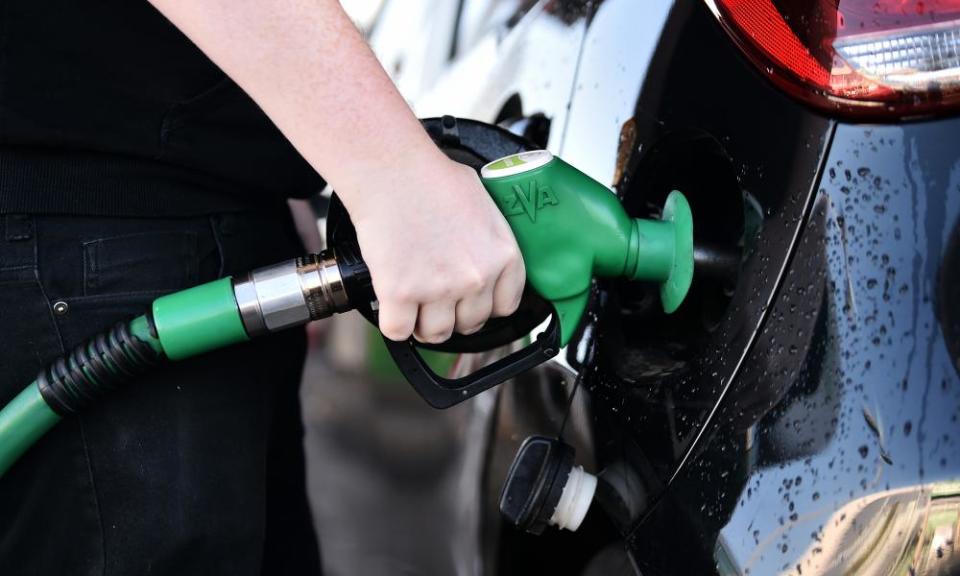UK inflation falls but remains in double digits at 10.1%

UK inflation fell for a third consecutive month in January, although it remained in double digits at among the highest levels in 40 years amid the cost of living crisis.
The Office for National Statistics (ONS) said the annual inflation rate as measured by the consumer prices index fell to 10.1%, continuing a decline from 10.5% in December and its recent peak of 11.1% in October. City economists had forecast a modest drop to 10.3%.
Related: Inflation calculator: find out how much UK household price rises affect you
The latest fall was driven by a continued drop in petrol and diesel prices for motorists at the start of the year, as well as the price of air and coach travel falling back after a steep rise in December.
Restaurant, cafe and takeaway prices also fell, while the cost of furniture dropped as retailers put on January sales.
The latest figures come as the Bank of England considers a further rise in interest rates to tackle inflation at the highest levels since the early 1980s, in a move adding to pressure on borrowers after 10 successive rate rises in the past 18 months.
Inflation remains higher than in the US or the 20 EU countries in the eurozone, and some forecasters have said the UK’s acute worker shortages and other constraints on the economy such as Brexit could add to inflationary pressure.
Grant Fitzner, the chief economist at the ONS, said the annual inflation rate had probably peaked after reaching the highest levels since 1981 in October. “Barring geopolitical risks and barring something completely unexpected, yes [it has peaked] … The general direction does seem to be south,” he said.
Rishi Sunak has promised to halve the annual inflation rate this year as the cornerstone of his economic plans. However, most economists forecast inflation to fall back over the coming months amid a drop in global energy prices, and as the initial surge in markets after Russia’s invasion of Ukraine drops out of the annual inflation rate.
It comes as wholesale energy and commodity prices have fallen sharply in recent months, including a drop in European gas prices to the lowest level in 17 months. However, prices still remain much higher than in recent years.
The chancellor, Jeremy Hunt, said: “While any fall in inflation is welcome, the fight is far from over. High inflation strangles growth and causes pain for families and businesses – that’s why we must stick to the plan to halve inflation this year, reduce debt and grow the economy.”
The ONS said there were further indications that costs facing businesses were rising more slowly than in previous months, driven by falls in crude oil, electricity, and petrol prices.
However, food and drink inflation remained at close to the highest rates since the 1970s, with the soaring price of milk, bread and other basic essentials pushing up prices by almost 17% in a year.
Rising prices for alcohol and tobacco also added to upward pressure on inflation, following on from seasonal price cuts in December.
Charities warned that the rising cost of a weekly shop was putting the most pressure on lower-income households, who spend proportionally more on basic essentials than those on higher incomes. The Resolution Foundation thinktank said the poorest 10th of households experienced an inflation rate of 11.7% in January, compared with only 8.8% for the richest.
Helen Dickinson, the chief executive of the British Retail Consortium, said food prices remained high because of the knock-on impact from rising energy and fertiliser prices after the invasion of Ukraine. “So as Christmas discounts faded away, households will have felt the pressure in their weekly grocery shop.”
The government is preparing to reduce the level of energy support for households and businesses this spring, amid concerns from charities and company bosses that Britain’s cost of living emergency is far from over.
Rachel Reeves, the shadow chancellor, said: “Despite Britain’s enormous potential, in April households will be hit by another economic blow when energy prices go up. With inflation still close to a 40-year high, people will be asking if 13 years of Tory government has left them and their family feeling better off. The answer will be no.”
Economists said the fall could ease the pressure on the Bank of England to raise interest rates above the current rate of 4%, the highest level since the 2008 financial crisis.
Services inflation fell back from 6.8% in December to 6% in January. The figure is closely watched by the central bank for signs that rising workers’ pay is leading to companies pushing up their prices.
James Smith, an economist at the Dutch bank ING, said: “A word of caution: one month does not make a trend. By definition, the Bank of England’s focus on ‘persistence’ suggests policymakers are going to be less fazed by month-to-month gyrations in this data. That said, our view is that services inflation has probably peaked.”

 Yahoo Finance
Yahoo Finance 